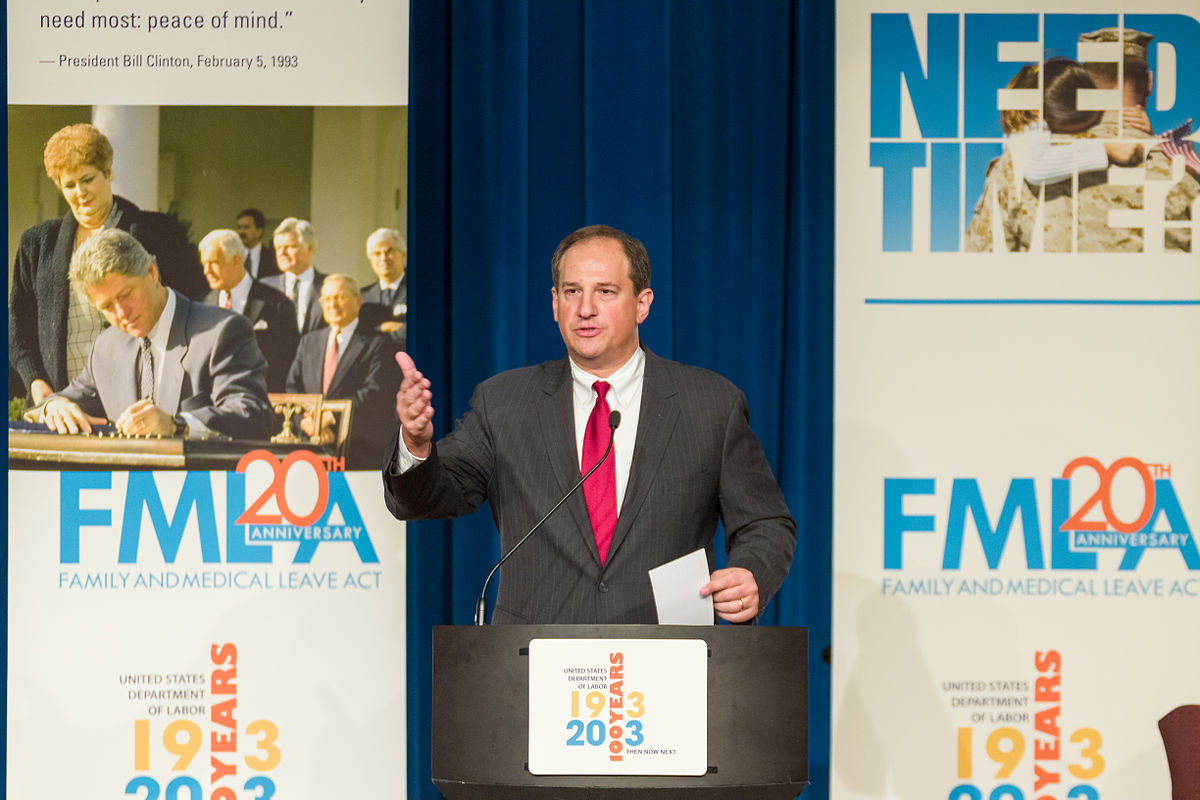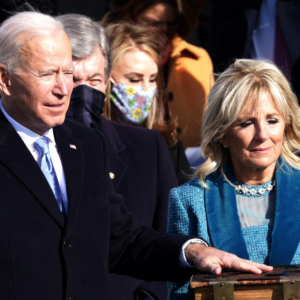
Seth Harris at the 20th Anniversary of the Family Medical Leave Act. Image via Wikimedia Commons
For a consummate policy insider who still has the ear of the people around the president, Seth Harris ILR ‘83, former deputy labor secretary turned Cornell distinguished scholar and global lawyer, is ready, after three decades of loyal service, to finally start speaking in his own voice.
A veteran of four Democratic transition planning teams – the little known cells charged with readying the government for incoming administrations – Harris was a trusted advisor as the administrations of President Clinton and Vice-President Al Gore and President Obama and Vice President Biden were being formed. In DC, a bubble full of glitzy self-promoters, Harris kept his head down and his shoulder to the wheel, ending up with the sort of blue-chip connections and executive influence others can only Tweet about.
As the Labor Department’s deputy secretary and chief operating officer for almost five years from May 2009 until January 2014, including a 6-month stint as acting secretary, Harris advised on myriad executive orders and regulations relating to jobs, wages, and disability rights, and oversaw the implementation of President Obama’s 2009 stimulus bill — the American Recovery and Reinvestment Act — that kept America afloat after the Great Recession. It was a relentless gig that kept him locked in rolling meetings overseeing 17,000 employees in 23 separate operating units boasting multi-billion dollar budgets, overlaid with the daunting task of turning political thought bubbles into reality.
Harris raked over the warm coals for Cornell HR Review in an exclusive interview towards the end of last year. “We implemented the largest stimulus bill ever, fought the worst economic downturn in seven decades, the worst oil spill ever, the worst mine disaster ever, and we saw the biggest demand on Labor Department services ever, right as the President was trying to wind down two wars and change the direction of the country.”
Harris signed on with then-Senator Obama in January 2007 – a full two years before the inauguration — and advised his Senate office and presidential campaign through Election Day. He began working to build the administration in August 2008 as a member of the agency review working group of the Obama-Biden transition planning team, and was tasked with overseeing the transition in 15 federal agencies, including the Labor, Education, and Transportation Departments. After the President’s swearing in, he was asked to manage the Labor Department as deputy secretary, assuming the position after being unanimously confirmed by the U.S. Senate in May 2009.
So why did he leave? “After 7 years I was pretty tired,” Harris says. “Folks who work in government at the level of which I was fortunate enough to work really owe it to the country to make an assessment about whether or not they are contributing as much value as they did when they entered the job.” But there was also another reason – the intuitive political operator realized that incoming secretary and good friend Tom Perez, after finding his feet with help from Harris, “needed space to operate…and I gave him that space”.
Harris returned to ILR in January 2014 as a distinguished scholar and is teaching the undergraduate labor and employment law class he once took as a freshman. A respected law professor and author, he made more than a dozen television appearances last year, is regularly quoted in the news media, and keeps up a steady barrage of blog posts. Most of them are on the issue du jour of economic inequality, especially the falling wages of the bottom quintile of wage earners, a situation Harris calls “unfair, unjust, bad for our country, and bad for our economy.” But his advice to the White House on how to tackle the problem remains strictly off-the-record: “As a public commentator I’m trying to elevate the issues I think are important to the country and to the people….but when I offer my advice it’s private and it’s carefully and reasonably phrased, it’s a different function.”
Harris cut his political teeth at the age of 10 on George McGovern’s disastrous 1972 presidential campaign, handing out leaflets as the candidate lost every state bar Massachusetts — “I learned about devastating defeat early on”. After graduating ILR, he became a field representative for the Seafarers International Union in Texas. He saw the daily struggle of working class life up close: “I will never forget those guys sitting around in a union hall, unemployed, some of them living in their cars, and it was entirely a consequence of public policy.” He remains tight with senior labor officials from that period, including legendary Seafarers president Mike Sacco and AFL-CIO boss Richard Trumka, whom he’s known personally for 30 years (“Rich collects people”, Harris explained).
In his mid-20s, Harris became convinced he could contribute to the lives of working people “at a higher level”, through public policy and enlightened government action. A law degree at NYU (in 1988 he ran Dick Gephardt’s presidential campaign in New York State out of his dorm room and was editor-in-chief of the Review of Law and Social Change) and high-profile clerkships followed, before a friend tapped him for the 1992 Clinton-Gore transition team. Soon enough, he was lured back to Washington to work as a special assistant to Labor Secretary Robert Reich, ascending to the role of counselor to Reich’s successor Alexis Herman. A few months before Gore’s loss in 2000, Harris moved to New York Law School, where he was a professor and director of Labor and Employment Law Programs until Obama came knocking.
Harris sounded a warning for both human resources and labor-side concentrators as they make their own ascent up the professional ladder. Union leaders, hamstrung by a “broken” labor law, have to find alternative mechanisms for getting to majority unionism beyond the NLRB election process, but also need to explore alternative models of worker organization such as worker centers and associate membership. He holds ILR alum Sarah Horowitz ‘84’s Freelancers Union up as an innovative model.
HR pros needed to be careful their bosses in the c-suite don’t view the HR function “as a cost center, rather than a profit center.” In unenlightened for-profit firms, line managers and product managers “tend to be more influential than even the SVP for HR.” The challenge is making sure HR is valued as a “critical element inside the corporate decision-making apparatus when it comes to compliance with employment law, benefits law and how you maximize returns for human capital…this can be a complicated task in a corporation that’s trying to make a profit, but also trying to conserve its most important resource.” Analytics need to be marshaled but only in a productive way – Harris singles out Starbucks’ use of data for just-in-time scheduling as a “really bad outcome”. He is currently advising companies on this and other matters in his role as an attorney and public policy specialist at global law firm Dentons.
After the “openly hostile” reign of Bush Labor appointee Elaine Chao, Harris was forced to put in place a “very aggressive” performance measurement system to get the department back on track. He wasn’t helped by Chao’s Democratic replacement, ex-California Congresswoman Hilda Solis, with whom he had a strained relationship.
Internally, Harris had to deal with two impressive professional unions, the independent National Union of Labor Investigators and the National Council of Field Labor Locals (an affiliate of the American Federation of Government Employees) with which he struck long-term collective bargaining agreements. But the leadership of a third union, AFGE Local 12, “were like the cast of One Flew Over the Cuckoo’s Nest nuts.”
“They have 5500 people eligible to join the union, but they have 500 members. No one wanted to be in this union. We had a terrible relationship with them and they thought we were anti-union. Part of the problem, Harris says, was the strange world of federal sector unionism, which prohibits bargaining over wages and conditions, “so you end up arguing over the dimensions of an office”. But the other problem lay with Local 12 President Alex Bastani, who farcically attempted to oust Harris as acting labor secretary in early 2013.
Stepping out of the maelstrom, Harris is now free to focus on weightier matters and front of mind is President Obama’s prospects for his final two years in the job. Hamstrung by a hostile Congress, can the hope of 2008 still shine through? Harris calls the “lame-duck” thesis “obsolete”, citing the President’s “immense” amount of inherent and delegated power under the Constitution: “He’s going to take action on immigration, he’s going take action on labor standards and raising wages, to create jobs wherever he can, he’s certainly going to take action on climate change and environmental issues. If the President of the United States were a lame duck you wouldn’t have the incoming leadership of Congress essentially begging him not to use his power to do things they don’t like. It sounds like threatening but it’s really because they know he has the power and can exercise it if he wants to.”
Harris, perhaps more than anyone else in DC, knows all about the art of the possible.





